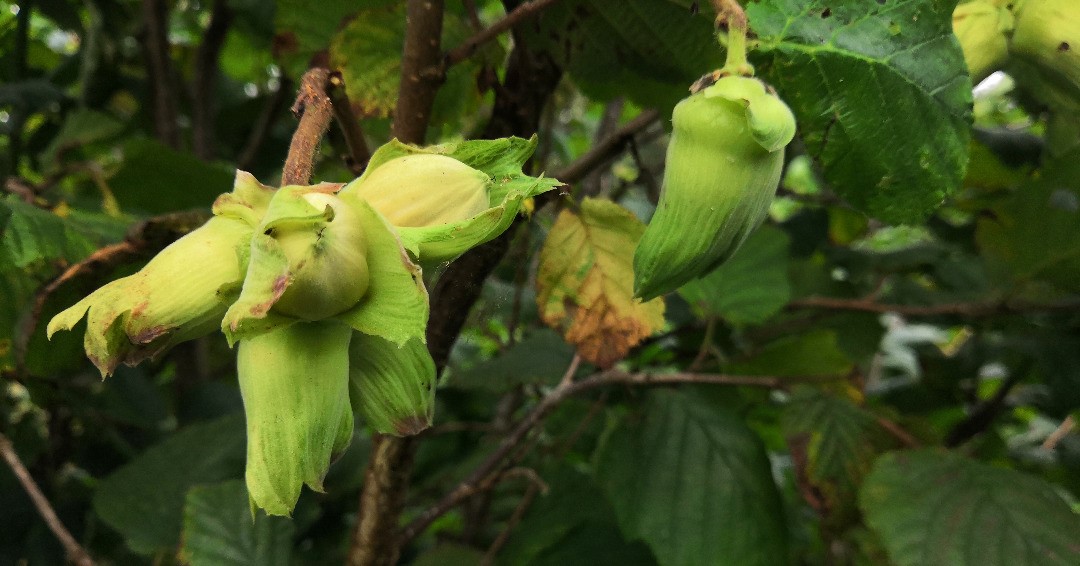Cob Nuts
What are Cob nuts?
Cob Nuts are selected Hazelnut cultivars that have been selected for production of nuts, ie. large nuts and regular crops. Regular Hazelnuts that you buy in the shop are produced from Cob nut trees.
In ancient times nuts collected from wild Hazel trees were an important harvest, since the 16th century Cob nut cultivars have been used for producing nuts in gardens and orchards.
So Webbs Prize Cob is a type of Hazelnut tree like Bramleys is a type of Apple.
Cob nut kernels typically contain 12%-17% protein by dry weight, and about 10%-15% fibre. Cob nuts are very rich in vitamin E and in calcium, typically containing about 21mg and 141mg per 100g kernel (dry weight) respectively. They provide about 0.4mg and 0.55mg of vitamins B1 and B6 respectively per 100g dry weight.
There are many different varieties of Cob nut.
Wild Oaks Nursery specialises in supplying varieties that do well in the Irish climate.
We base our selection on research done by Andy Wilson of Fruit and Nut up in Mayo and Martin Crawford from the Agroforestry research trust in South West England and a steadily growing number of Irish hazelnut growers.
In our opinion Cob nuts are the most viable nut crop for the Irish climate
Cultivation
Cob nuts are Hardy and tolerate a wide range of soil types except waterlogged soils
They do best on a light top soil with free draining sub soil, they prefer neutral to alkaline soils but will tolerate more acid soils. Ph 5.5-7.5
Spacing
Approx 4m apart,
for high production 4.25mx 3m with good pruning.
Yield
3-5kg per tree,
occasionally upto10kg
harvests can be quite varied.
Climate range
As a rule of thumb they will crop well wherever apple trees will grow
They like a bit of shelter and are fairly frost tolerant prefer full sun
Pollination
Cobs are wind pollinated and need minimum of 2 varieties,
we recommend 3 varieties.
Wild hazel can pollinate if within 45m, this depends on flowering times coinciding
some wild hazel flower too early but if there are a few around its likely some will flower at the right time.
Pruning
For high yields pruning will help
Some orchards chose single main stem and then prune to shape like a goblet apple tree
ie, an open middle with 4 main branches coming from main stem, well spread, keeping height down to 8ft
Another option is to limit to 5 main branches and remove any shoots at the base and any dead wood, every few years letting a younger shoot to grow to replace oldest stem.
Pruning in February helps with pollination as you will end up shaking the branches and stir up the pollen.
Varieties
Cosford
A very reliable variety has performed well in many different condition. Good Pollinator for other varieties. Fast growing, a good all round tree.
Halls Giant
Hardy, very vigorous and productive variety with large nuts. Good flavour. Probably the most vigorous of all the cobnuts listed here.
Nottingham also known as Pearson’s Prolofic
Early ripening and prolific cropper, with tasty nuts. Relatively vigorous grower in early years. Fast to come into production, crops from third or fourth year. Very tasty nut. Has performed well in Irish trials.
Red Zellernut
Vigorous and very attractive tree. Large nuts with very good flavour. Leaves and husks are bronze red.
Webbs Prize
Large sweet nut, prolific cropper. Compact tree, good for small gardens. Great flavour from nut. Quite slow in early years.
EMOA 1
A modern cultivar from Holland performing well in trials in UK and the Netherlands. Good yields of large nuts.
Kentish
Traditionally grown in Kent UK but thought to be from France originally. Compact, hardy variety with exceptionally tasty nuts.


Recent Comments